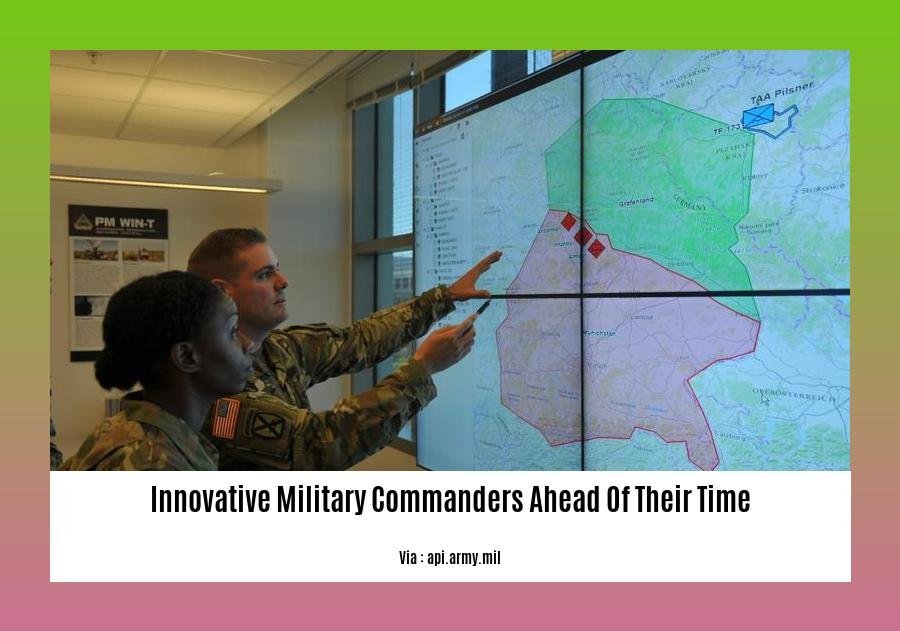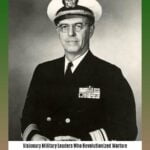Prepare to delve into the extraordinary world of Innovative Military Commanders Ahead of Their Time: Reshaping the Art of Warfare. We will explore the groundbreaking strategies and tactics of Frederick II of Prussia, Gustavus Adolphus, Jan Žižka, and Genghis Khan, whose visionary minds transformed the landscape of warfare. From their innovative weaponry to their daring strategies, these commanders pushed the boundaries of military science, leaving an indelible mark on history.
Key Takeaways:

- Encourage innovation throughout the army, from senior leaders to ground troops.
- Hold innovation competitions among units to gather ideas and prototypes.
- Invest in innovation to stay ahead of adversaries and anticipate future military needs.
Innovative Military Commanders Ahead of Their Time
Throughout history, innovative military commanders have played a pivotal role in shaping the art of warfare. They defied conventions, embraced novel strategies, and pushed the boundaries of military technology, leaving an indelible mark on the battlefield.
By leveraging cutting-edge tactics, weaponry, and leadership styles, these commanders transformed how wars were fought, giving their armies a tactical edge over their opponents. Their innovative approaches not only secured victories but also set the stage for future advancements in military strategy.
From Alexander the Great’s innovative use of cavalry to Hannibal’s brilliant ambush tactics at Cannae, these innovative military commanders revolutionized warfare, leaving behind a legacy of leadership and strategic genius that continues to inspire generations of military leaders today.
pioneering military geniuses before their era and their astute strategies overturned conventional doctrines, redefined military tactics, and reshaped the course of history. In the annals of warfare, these groundbreaking commanders who upended traditions stand as beacons of innovation, their brilliance casting a long shadow across the battlefield. From Alexander’s audacious tactics to Napoleon’s unprecedented maneuvers, these visionary military leaders who revolutionized warfare shattered paradigms and forever altered the art of war.
Jan Žižka (1360—1424)
Jan Žižka, a legendary Bohemian military commander, emerged as a beacon of innovation on the battlefields of the 15th century. Leading the Hussite armies against the formidable German king, Sigismund, Žižka’s military prowess and ingenuity transformed the face of warfare, leaving an enduring legacy that continues to inspire military strategists today.
Žižka’s Innovations:
Mobile Artillery: Žižka revolutionized warfare by introducing mobile artillery, mounted on horse-drawn wagons. This innovation provided unprecedented firepower and mobility, allowing his armies to outmaneuver and outgun their opponents.
Wagon Fortresses: Žižka’s armies utilized fortified wagon formations, known as “wagenburgs,” creating mobile defensive positions that protected his troops from cavalry charges and artillery fire.
Taborites: Žižka established a religious community of followers, known as the Taborites, who embraced radical military tactics and innovative weapons.
Key Takeaways:
- Adaptability and Ingenuity: Žižka’s ability to adapt to changing battlefield conditions and develop innovative tactics allowed him to overcome seemingly insurmountable odds.
- Importance of Mobility: Žižka’s mobile artillery and wagon fortresses emphasized the significance of flexibility and speed in military operations.
- Leadership and Inspiration: Žižka’s charisma and leadership skills inspired his followers to fight with unwavering determination and embrace his innovative tactics.
Citation:
- “Jan, Count Žižka.” Encyclopedia Britannica,
Genghis Khan (1162 – 1227)
Visionary Military Commander and Empire Builder
Genghis Khan (1162 – 1227) emerged from the Mongolian steppes to become one of the most influential military leaders in history. His innovative tactics and strategies transformed warfare and left an enduring legacy on global politics.
Innovative Military Reforms
Genghis Khan’s brilliance as a military strategist was evident in his groundbreaking reforms:
- Cavalry-Centric Army: He reorganized his army into cavalry-based units, utilizing the mobility and speed of horses to outmaneuver opponents.
- Decimal Organization: Troops were organized into decimal units (tens, hundreds, thousands, etc.), ensuring efficient command and control on the battlefield.
- Discipline and Training: Genghis Khan enforced strict discipline and rigorous training within his army, fostering a highly skilled and cohesive force.
- Siege Warfare: He pioneered the use of siege warfare tactics, employing innovative machinery to breach enemy fortifications.
Key Takeaways:
- Innovation can revolutionize military effectiveness.
- Adaptability and mobility are crucial for battlefield success.
- Leadership and discipline are essential for army cohesion.
- Technological advancements can enhance military capabilities.
Legacy and Impact
Genghis Khan’s military innovations had a profound impact on the course of history. His conquests established the Mongol Empire, which stretched from the Pacific Ocean to the borders of Europe. His legacy as a military strategist continues to inspire and influence military leaders to this day.
Citation:
- Britannica:

FAQ
Q1: Who is considered an innovative military commander who was ahead of their time?
A1: Some innovative military commanders who were ahead of their time include Frederick II of Prussia, Gustavus Adolphus, Jan Žižka, and Genghis Khan.
Q2: What innovative tactics did Frederick II of Prussia introduce?
A2: Frederick II of Prussia introduced the “oblique order” tactic, which allowed his army to outflank and defeat enemy armies.
Q3: How did Gustavus Adolphus revolutionize warfare?
A3: Gustavus Adolphus introduced new infantry tactics, such as the use of volley fire and the creation of smaller, more mobile units.
Q4: What was Jan Žižka’s significant contribution to the development of military tactics?
A4: Jan Žižka introduced mobile artillery and emphasized the use of infantry over cavalry, which foreshadowed the revolution of military tactics two centuries later.
Q5: How did Genghis Khan’s military reforms contribute to the success of the Mongol Empire?
A5: Genghis Khan’s military reforms, such as the organization of troops into decimal units and the use of siege warfare tactics, revolutionized warfare and facilitated the expansion of the Mongol Empire.
















